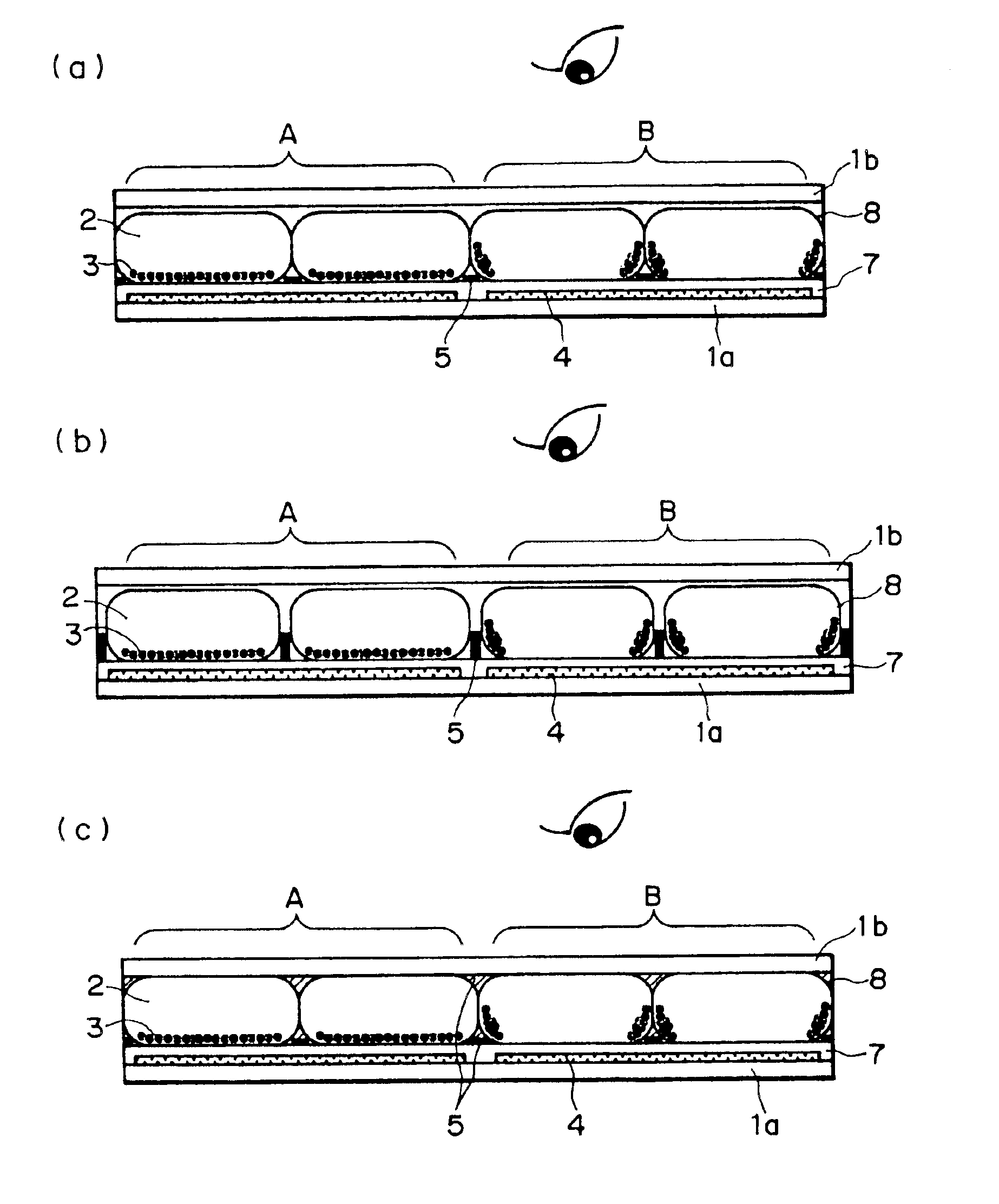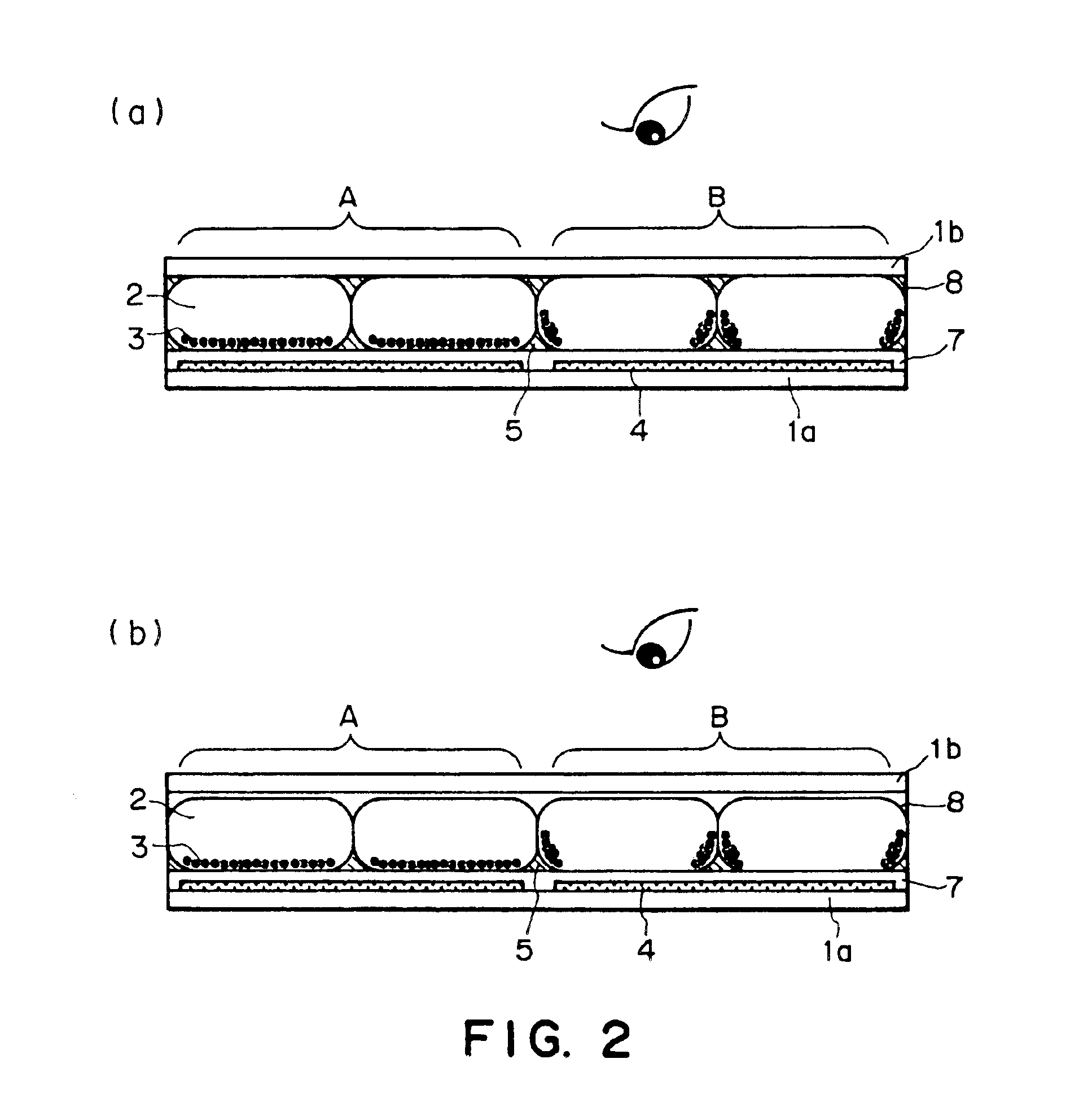Electrophoretic display
a display and electrophoretic technology, applied in the field of electrophoretic display, can solve the problems of reducing the life or stability of the electrophoretic display as a display apparatus, affecting the display stability, and affecting the display stability, and achieve the effect of excellent display stability and high-contrast display
- Summary
- Abstract
- Description
- Claims
- Application Information
AI Technical Summary
Benefits of technology
Problems solved by technology
Method used
Image
Examples
example 1
An electrophoretic display having a structure shown in FIG. 1 was prepared by the above-mentioned first production process shown in FIG. 7.
The size of each (one) pixel was set to 100 μm×100 μm.
As a first substrate 1a, an aluminum thin film was formed on a surface of a (200 μm-thick) PET film, followed by patterning through a photo-lithographic or wet etching process to form a plurality of first electrodes 4. White coloring layers were formed so as to cover these first electrodes 4. These white coloring layers 4 were formed of an acrylic resin and a white pigment, such as titanium oxide (used in this example) or alumina, dispersed in the acrylic resin.
Then, an insulating layer 7 of an acrylic resin was formed so as to cover the white coloring layers.
Microcapsules 8 were prepared by a combined coacervation method. As an insulating liquid 2, isoparaffin (trade name: “Isopar”, mfd. by Exxon Corp.) was used, and as charged electrophoretic particles 3, particles of polystyrene-polymethyl ...
example 2
An electrophoretic display having a structure shown in FIG. 3(b) was prepared in the following manner.
The size of each (one) pixel was set to 180 μm×180 μm.
As a first substrate 1a, an aluminum thin film was formed on a surface of a (180 μm-thick) PES film, followed by patterning through a photo-lithographic or wet etching process to form a plurality of first electrodes 4. White coloring layers were formed so as to cover these first electrodes 4. These white coloring layers 4 were formed of an acrylic resin and a white pigment, such as titanium oxide (used in this example) or alumina, dispersed in the acrylic resin.
Then, an insulating layer 7 of an acrylic. resin was formed so as to cover the white coloring layers.
Onto the entire surface of the insulating layer 7, an electroconductive resist was applied, followed by patterning in a shape shown in FIG. 3(b) to form a second electrode having a width of 5 μm and a height of 15 μm. As the electroconductive resist, it is possible to use t...
example 3
An electrophoretic display having a structure shown in FIG. 3(c) was prepared by the fifth production process shown in FIG. 9.
The size of each (one) pixel was set to 180 μm×180 μm.
As a first substrate 1a, an aluminum thin film was formed on a surface of a (1.1 mm-thick) glass substrate, followed by patterning through a photo-lithographic or wet etching process to form a plurality of first electrodes 4. White coloring layers were formed so as to cover these first electrodes 4. These white coloring layers 4 were formed of an acrylic resin and a white pigment, such as titanium oxide (used in this example) or alumina, dispersed in the acrylic resin.
Then, an insulating layer 7 of an acrylic resin was formed so as to cover the white coloring layers.
Then, on the surface of the insulating layer 7, an ITO (indium tin oxide) film was formed, followed by patterning through a photolithographic or wet etching process to form a plating electrode 51 having a width of 5 μm.
Microcapsules 8 were prep...
PUM
| Property | Measurement | Unit |
|---|---|---|
| height | aaaaa | aaaaa |
| height | aaaaa | aaaaa |
| particle size | aaaaa | aaaaa |
Abstract
Description
Claims
Application Information
 Login to View More
Login to View More - R&D
- Intellectual Property
- Life Sciences
- Materials
- Tech Scout
- Unparalleled Data Quality
- Higher Quality Content
- 60% Fewer Hallucinations
Browse by: Latest US Patents, China's latest patents, Technical Efficacy Thesaurus, Application Domain, Technology Topic, Popular Technical Reports.
© 2025 PatSnap. All rights reserved.Legal|Privacy policy|Modern Slavery Act Transparency Statement|Sitemap|About US| Contact US: help@patsnap.com



